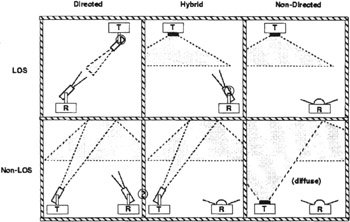2 Wireless infrared transmissions
2 Wireless infrared transmissions
We firstly summarise the history of some of the applications and position the project in its context.
Several research teams have already studied indoor wireless transmission links (Figure 16.1) spectrally centered on 1550 nm. The two closest experiments concerning INDEED project are summarised in Table 16.1. Direct light detection and On Off Keying (OOK) modulation are used. The experimental results given in this table correspond to a bit error rate (BER) of 10 ˆ’ 9 .

Figure 16.1: Different types of wireless transmissions [Kahn, 1997]
| Reference | [Wisely, 1997] ‘ | [Jungnickel, 1998] ‘ |
|---|---|---|
| Transmitter power Tx | + 8dBm 16 Tx | +7 dBm 1 Tx |
| Receiver surface | Bootstrapped 1 mm 2 | Unegalised 0.04 mm 2 |
| Photo-detector | PIN | APD |
| Sensitivity Rx | ˆ’ 32 dBm | ˆ’ 39 dBm |
| Optical filter Attenuation | Yes ˆ’ 1 dBm | No |
| Concentrator Gain Surface/FOV | Yes +23 dB /10 ° | Lens ˆ’ 6 dB 25 cm 2 / |
| Cell area dimensions | 1 m 2 4 —4 —2 m 3 | 20 m 2 room H=2 m |
| MAC Protocol | CSMA/CD | |
| Rate | 100 Mbit/s | 140 Mbit/s |
| Propagation loss | ˆ’ 60 dB | ˆ’ 46 dB |
| Margin | +3 dB | No |
Wisely (British Telecom member) considers an area divided into cells and illuminated by 16 transmitters with a total power of 6.3 mW (8 dBm) and receivers with bootstrapped large area PIN photo detectors in a "line-of-sight" (LOS) scheme.
In the non-LOS system proposed by Jungnickel (Institut Heinrich-Hertz, Berlin), the transmitter output power is 5 mW (7 dBm). The incident light shines on the avalanche photodiode through a concentrator. There is no power margin in the case of the Jungnickel's system. Experimental improvements have been obtained at higher bit rates using network access protocol, here CSMA/CD.
EAN: 2147483647
Pages: 191